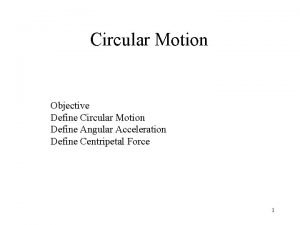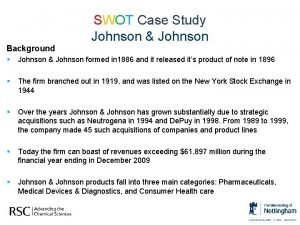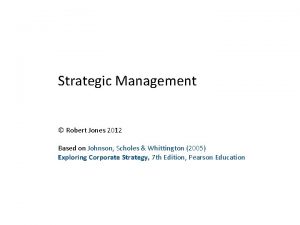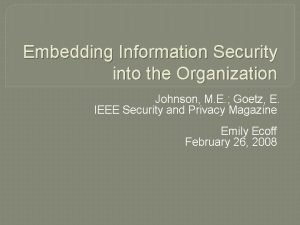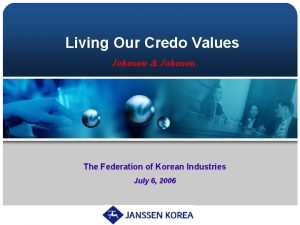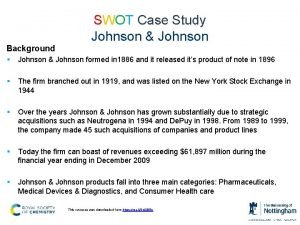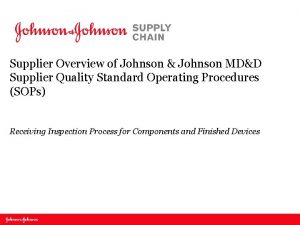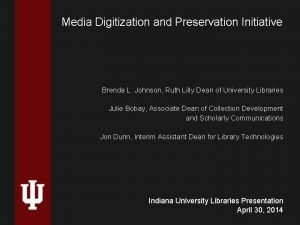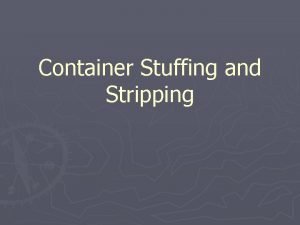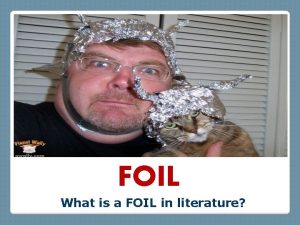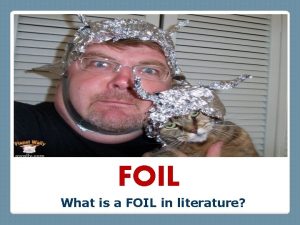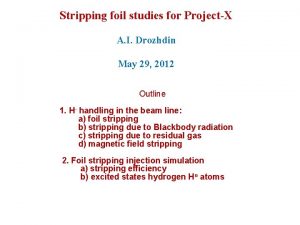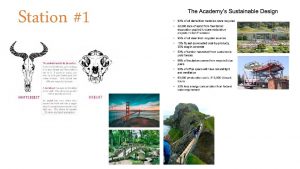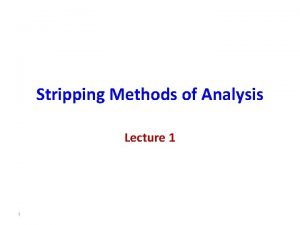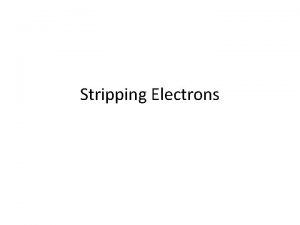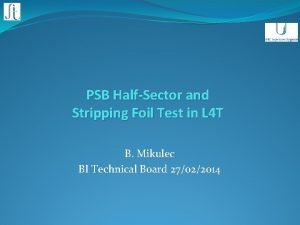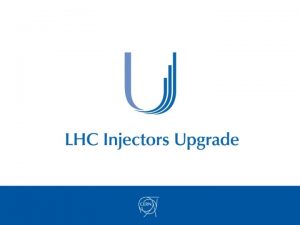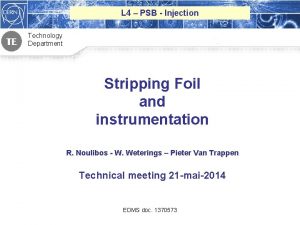Rotating Foil and Stripping Station Studies Dave Johnson












- Slides: 12

Rotating Foil and Stripping Station Studies Dave Johnson (APC) and Zhijing Tang (PPD) May 29, 2012

Motivation – Single pass Stripping station • Beam line (3 Ge. V H- transport) – At 3 MW, losses are an issue (Lorentz stripping, black body rad. ) » Currently limited fields (restricted footprint) and Cold beam tube – Convert to protons w/stripping station eliminates these issues • 1 Ge. V (1 MW) to Nuclear facility – Potential ADS Technology Demonstration » Requires protons for vertical orientation – Multi-pass injection stripping foil • 8 Ge. V injection into Recycler ( multiple short injections 1 m. A-4 ms x 6 inj @ 10 Hz or a single “long pulse” 1 m. A-25 ms injection) • 1 Ge. V injection into Booster (CW linac, ≈ 1 ms inj. 15 Hz rep) • Injection into high intensity storage rings – Why rotating foils • Spread energy deposition over larger area to reduce peak temperatures • Does not help with losses due to scattering – A preliminary estimation for a Project X “long pulse” injection scenario performed by A. Drozhdin, L. Vorobiev, S. Striganov, and I. Rakhno utilizing a moving strip foil indicates a reduction in temperature… to be discussed in next presentations

Typical H- Stripping Foil Material • Carbon – Amorphous Carbon (such as Arizona carbon) – HBC (Hybrid Boron doped Carbon) KEK – DLC (diamond-like-carbon) Trumph • Aluminum-oxide • More recently polycrystalline (including nano- and ultranano- )diamond foils have been pioneered and utilized by SNS

UNCD Properties • General material properties – Young’s modulus: ~ 850 -1100 Gpa – Large fracture strength: ~ 4 GPa for UNCD • (free standing sheets are flexible and strong) – – – – Density: ~3. 3 g/cm 3 Poisson ratio: ~0. 057+/-0. 38 Mohs hardness: 10 Dielectric constant: ~5. 68 Electrical resistance ( depends on doping) 10 -1 to 10+4 Ω-cm Breakdown voltage: ~108 V/m Thermal conductivity (depending on grain size) 12 -1500 W/m-o. K Coefficient of linear expansion ~10 -6/o. C • Not a DLC (amorphous form of carbon) coating or film • Self supporting • Grown in wafers up to 300 mm diameter (thickness 0. 1 to ~2 mm) – Can be corrugated, etched, and diced for shaping of final foil geometry • Chemistry (atmosphere), multiple element deposition, grain control impact ultimate thermal, electrical, and mechanical properties

Approach (1) • Single Pass (want 100% neutralization) – MARS- for loss distributions/activation – ANSYS- thermal/mechanical simulations • Multi-turn Injection (typically 98 to 99%) – Utilize codes such as ORBIT and STRUCT for determination of parasitic hit distribution on foil as a function of • Ring and injection line lattice • Painting algorithm • Injection beam current, injection time, and rep rate – Losses due to scattering – Losses due to Stripping of excited states (Stark states) – ANSYS for thermal and mechanical simulations

Approach(2) • Develop ANSYS model of rotating foil to investigate thermal and mechanical properties – Utilize general UNCD properties for initial model (in consultation with CNM) as a starting point – Utilize existing energy deposition and foil temperature estimations based upon MNCPX and MARS simulations – Understand physical, thermal, and electrical characteristics requirements due to rotation and beam impact (structural, thermal, electrical, etc) What’s important & and how to specify material properties (strength, uniformity, thermal acoustic, and electrical properties) – Understand capabilities of CNM (Argonne)/Advanced Diamond Technologies – Understand the diamond-to-graphite conversion due to ion bombardment • Prototype disk – Design of rotational system – Design a disk which meets the physical and thermal requirements – Plan for temperature and foil dynamics measurement • Beam test (at FNAL) 400 Me. V and/or 8 Ge. V or potentially SNS

First Example – single pass stripping • Assume 1 m. A average linac current at 3 Ge. V in 162. 5 MHz bunch structure ~4 E 7 ions/bunch assuming all bunches are filled equally t bunch (pulse length), t rep rate 1 – Bunch length ~1 ns – Bunch repetition rate 6. 15 ns – Assume Gaussian beam with s=2 mm 2 t 1 • Assume foil thickness 2 mm and density 3 g/cm 3 (600 mg/cm 2) 2 micron UNCD film (surface structure may be required Si substrate Copper 82 mm 6 mm 20 mm H- beam t = 30 ms w = 2, 000 rpm w

Thermal Model ANSYS simulation developed by Zhijing Tang t 1 t 2 h foil thickness k thermal conductivity t 1 [J-kg/o. K] Heat source term 1, 0, * For now ignore delta electrons N is the #ions/bunch (pulse length), t 2 rep rate

Preliminary ANSYS Simulations ANSYS simulation developed by Zhijing Tang Thermal Analysis From NIST tables d. E/dx through amorphous carbon (1 p-2 e) 4. 95 Me. V-cm 2/g Neglecting any reduction of energy deposition from delta electrons For a bunch intensity of 4 E 7 ions the energy deposition for single bunch (SI) u ~ 3. 2 x 10 -6 J-m 2/kg Instantaneous power (ruh) into foil ~19 W average power t 1/t 2 P 0 ~3 W Consider heat source continuous with time Time scale for conduction Time scale for radiation Static solution

Increase Beam power ANSYS simulation developed by Zhijing Tang Assume hit rate of 5. 15 E 14 proton/mm 2 over 30 ms and constant hit rate Bunch intensity ~1 E 8 Average heating ~8 W Outer radius = 8. 4 cm, inner radius = 2 cm. From r = 2 to r = 6 cm, thickness = 100 microns; from r = 6 to r = 8. 4 cm, thickness = 2 microns. Rotation speed = 2000 rpm. Heating power = 8 W on a spot size = 1 x 2 mm 2 (r = 8 cm). r = 3 g/cm 3, k = 1370 W/m-K, e = 0. 5, Boundary condition is the temperature at r = 2 cm and the enclosure temperature = 300 K. Use a static solution as initial condition, following is the temperature distribution after 5. 6 cycles.

Mechanical Analysis ANSYS simulation developed by Zhijing Tang What are the design parameters for a foil to rotate at high speeds? Interested in stresses in the foil while rotating and with the addition of heat natural frequencies of oscillation buckling amplitudes ANSYS Mechanical Model (stress for a rotating thin disk) Stress proportional to square of rotational speed and radius. All stresses are positive (under tension) when no thermal load Stress due to centrifugal force ~0. 4 MPa for r=8 cm and speed 2000 rpm Thermal stress proportional to temperature change ~. 13 GPa for temp change of 150 o. K

Summary/Next Steps • ANSYS simulations have just began • Start injection simulations • Move forward for beam test of UNCD foil
 Rotating space station physics problem
Rotating space station physics problem Swot analysis of johnson and johnson
Swot analysis of johnson and johnson Johnson and johnson bcg matrix
Johnson and johnson bcg matrix Johnson and johnson organizational structure
Johnson and johnson organizational structure Jnj credo hotline
Jnj credo hotline Johnson and johnson botnet infections
Johnson and johnson botnet infections Johnson & johnson swot
Johnson & johnson swot Jjeds jnj directory
Jjeds jnj directory Dreikurs classroom management theory
Dreikurs classroom management theory Johnson and johnson md&d
Johnson and johnson md&d Laurie johnson brad johnson
Laurie johnson brad johnson Reelsloader
Reelsloader Paradigm shift from women studies to gender studies
Paradigm shift from women studies to gender studies
